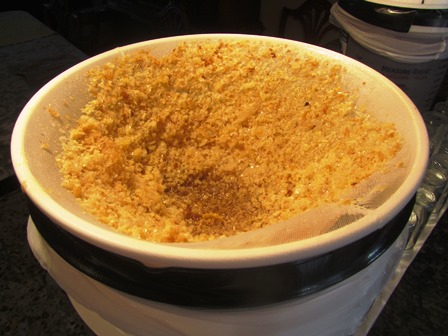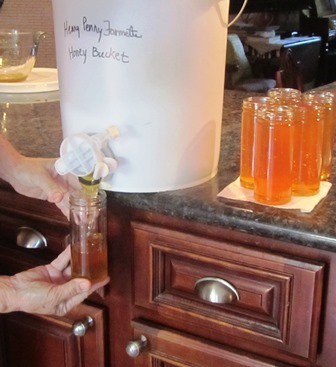A Good Day to Strain, Drain, and Bottle Honey
It’s Sunday. I’m bottling the honey that I pulled from the hives last week. Yesterday, I washed two dozen eight-ounce jars in the dishwasher and allowed them to dry upside down on paper towels. Today, I’ll put on my apron and listen to some energetic big band tunes while I drain that honey into jars.
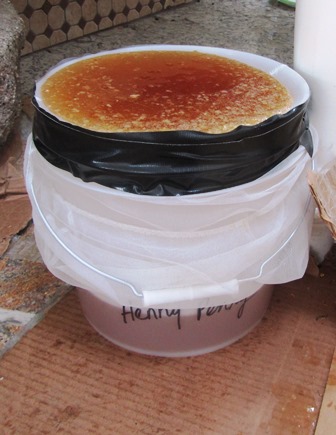
The fine mesh strainer taped tightly around the bucket rim traps the bits of wax but does not impede the flow of honey
My buckets of honey still have duct tape around their rims holding the strainers in position. When the honey was spun in the extracting machine, it had to be drained through a filter. Painter’s filters work great as the mesh cloth is very fine and fits over the top of the bucket.
The filter is placed into position around the rim and then duct taped is wrapped around tightly two times. Honey is quite heavy and can pull down the filter if not secured. I’m straining the honey that goes into jars. However, I did save back a jar of unfiltered honey with all those bits in it for a family member who prefers it that way.
The work was easier and went faster than I’d expected. It helps to have everything you need close at hand, clean, and ready to go.
Of the three large buckets, the first had a nice spigot than I could turn off after I allowed honey to flow and fill the jar. Then I closed the spigot, wiped the jar with a damp paper towel, and then screwed the lid in place.
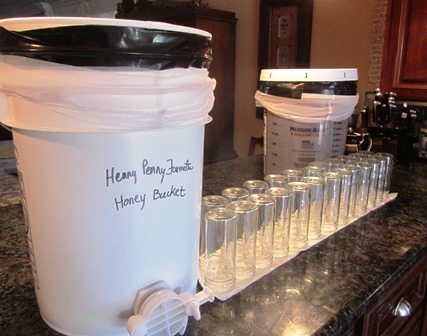
This five-gallon honey bucket will fill approximately five dozen eight-ounce jars; pictured here are 24 jars
The two dozen eight-ounce jars barely made a dent in my first honey bucket although my neighbor tells me that I can easily fill five dozen of the eight-ounce jars from one five-gallon bucket; or, I can fill two and one-half dozen of the sixteen-ounce jars.

Filled jars reveal clear, light amber honey the bees made from the French perfume lavender on my farmette and our springtime flowers, but these jars still labels
The next step in the process is to affix my Henny Penny label onto the jar. I plan to give some of these jars away during promotions in early October for my forthcoming novel, A BEELINE TO MURDER, the first in the Henny Penny Farmette series of cozies.
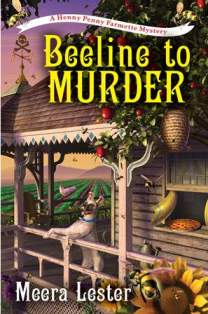
Published next month by Kensington, my book is available on Amazon, Barnes & Noble, and through most booksellers and online bookstores
If you are interested in this honey, please feel free to email me at meeralester1@gmail.com.
Plunging Temperatures–The Perfect Time to Bring Out the Honey
Cold and flu season is upon us. Here in Northern California, temps are plunging into the 20s and 30s and snow may be on its way. It is important to have a strong immune system to fight off these winter maladies.

A frozen sheet of ice blocks the cork (permitting honeybees to drink) from moving in our backyard fountain
I’m taking down another jar of honey from the shelf where I stacked the jars over the summer. One teaspoon of raw buckwheat honey taken daily has been recommended by doctors as a powerful booster for the immune system. See http://www.prweb.com/releases/honey/buckwheat-honey-raw/prweb10242276.htm.
With the weather change comes the cold and flu season, so I shouldn’t have been surprised that my husband came home from work yesterday feeling out of sorts. Our neighbors have all been sick with colds and he’s concerned that he might have caught the bug.
I made him a cup of hot ginger tea, sweetened with raw honey. Honey can be consumed directly from the spoon or in hot water or in a tea or infusion with lemon.
I became a believer in honey and ginger tea years ago while studying Tai Chi. My 84-year-old teacher swore by drinking hot tea made by steeping an inch or two of fresh, peeled ginger and adding lemon and honey. Her stamina was nothing short of remarkable–she not only did Tai Chi, but sang opera, painted Chinese brush paintings, and taught many classes on herbs, reflexology, and other aspects of health and fitness in California and Hawaii.
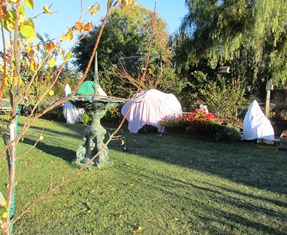
Using sheets and blankets, we’ve covered the citrus trees around our farmette as temps are expected to plunge into the 20s tonight
Holistic practitioners have long espoused belief in the healthful benefits of raw honey. Honey was used by the ancient Greeks and Romans for a variety of maladies. Modern medical doctors and researchers have extolled honey’s antiseptic, antibacterial, and anti-inflammatory properties, and many cold and flu preparations contain honey as an ingredient. It a cost-effective way to treat a cough. See http://www.mayoclinic.com/health/honey/AN01799
Honey is the only food on the planet that does not go bad. It may crystallize, but it never becomes sugar. Crystallized honey in a jar can be returned to liquid by removing the lid and setting the jar in warm water. Never heat honey in the microwave or boil it because it will destroy the natural enzymes. And never give honey to a child under the age of one year because of the risk of their developing botulism.
You don’t have to wait to start gaining the benefit of raw honey. You can strengthen your immune system now before the dreaded cold and flu sweeps through your neighborhood. Daily consumption of a teaspoon of raw honey (from flower-fed bees) that has been minimally filtered can be good for your health and, especially, your immune system.
 Facebook
Facebook Goodreads
Goodreads LinkedIn
LinkedIn Meera Lester
Meera Lester Twitter
Twitter




